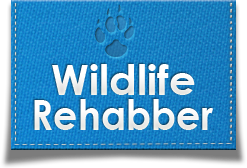Rehabilitators have a variety of preferences for the design and all the variables have been included to help you design a deer pen that best fits your needs. Newborns or debilitated young: Plastic airline crate large enough to allow the fawn to stand with it?s head up and be able to turn around comfortably in … Continue Reading
Patrick R. Thrush © 1999 (reprinted with permission from author) One of the most commonly asked questions by birdkeepers about cage lighting concerns the effective and proper usage of full spectrum (or FS) lighting devices. Little ‘fact’ exists as to the type of lamp to be used, the correct distance of the lamp assembly to … Continue Reading
Feathers and flight are the primary facets of bird rehabilitation that make it uniquely more difficult than mammal rehabilitation. Feather condition is as critical during the course of release for birds as is the ability to fly. Any type of damage to the feather structure will impede a bird’s ability to fly, waterproof, and thermoregulate. … Continue Reading
Ascaridia spp. (large roundworm of birds) Nematode From earthworms, eggs in avian feces or in contaminated water Size varies by species, females 20-120 mm, males 16-76 mm Small intestine Most serious in birds 1-3 months old Heavy infestations can cause partial or complete obstruction of the intestinal lumen resulting in reduced gastrointestinal motility or stasis; … Continue Reading
This basic aviary plan is the cummulative effort of our members. Rehabilitators have a variety of preferences for the design and all the variables have been included to help you design an aviary that best fits your needs. Aviary considerations are included. As an additional option to streamline construction, you can purchase kits to help … Continue Reading
The beak of a bird is considered a lightweight, bony elongation of its skull. The structure of the beak is covered with keratin, the same material found in human fingernails and hair. On many birds, the keratin dries to form hard, glossy, outer covering. The keratin renews on the tip and edges of the beak … Continue Reading
The ability to identify and address wing fractures is a necessity for all avian rehabilitators. Even if you are fortunate enough to have a veterinarian readily available to treat all your birds, you should still be familiar with wing wraps in order to stabilize fractures prior to treatment. An understanding of avian anatomy is critical. … Continue Reading
We go to great effort and expense in attempting to provide the appropriate diet to the variety of species in our care. Yet we actually have a self-renewing resource readily available to us. After extensive research by the medical community regarding the use of larvae in human wound management, the culturing of house fly larvae … Continue Reading
Unfortunately there is not a lot of information available regarding the nutritional requirements of wild birds. Most nutritional research has focused on species that are used as food by humans, with emphasis on chickens. Research has recently been branching out towards the nutritional needs of our companion birds. But it will be a long time … Continue Reading
A. Mouth 1. The Mouth consists of the upper maxilla and the lower mandible and is called the beak2. Lack of teeth may be an adaptation for flight, birds have lighter jaw bones and muscles. 3. The beak and tongue manipulate food. Lacking a soft palate, and the hard palate is divided by a … Continue Reading
